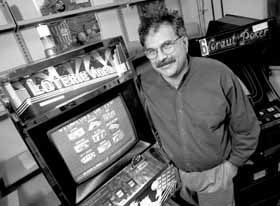
| ||
 | ||
 PHOTO: CLIFF SKARSTEDT |
Getting high on gambling
|
SYLVAIN COMEAU | The hottest new drug sweeping North American high schools and college campuses has nothing to do with needles, pipes or pills. It's often called an "invisible addiction," but for a rising number of students, gambling is proving as addictive Dr. Jeffery Derevensky, a professor of educational and counselling psychology, is trying to find out why, and what can be done about it. With a group of graduate students, he is conducting 24 separate studies on youth gambling and his findings so far are alarming. "Four to eight per cent of adolescents throughout the U.S. and Canada have a serious gambling problem Derevensky has been investigating compulsive gambling for about five years. His research, funded mostly by Loto-Québec since 1994, actually started as a surprising outgrowth of his previous studies of children and game playing. "One early study we did found that people who play a lot of video games, both male and female, seemed to be gambling much more than people who don't play video games. We believe that there is a transfer of learning and of an illusion of control which is then put on to gambling activities." That transfer is inappropriate and dangerous, according to Derevensky. "When you play a video game, the more you play, the better you get. What looks so random popping up on the screen is really not so random; there are rules built in and that's why people become better as they play. "These same people are more likely to think that they can also become better players with slot machines or VLTs [video lottery terminals], for example, which is not the case. But that belief encourages them to gamble again and again." According to much of the gambling literature and Derevensky's own studies, most pathological gamblers start playing before the age of 15, many as young as nine or ten. The question is: why are there so many young gamblers now, and why are so many of them out of control? The first answer is availability. "This is the first generation to grow up at a time when gambling is so widely available. Going to a bar used to be the common rite of passage; now, for lots of kids, it's going to the casino." The Montreal Casino opened its doors in 1993, has since expanded twice and is now open 24 hours a day. At the same time, VLTs, popularly known as "the crack cocaine of gambling," spread into nearly every bar in town. Derevensky says that adolescents and young adults are at least twice as likely as older adults to become pathological gamblers. "Adolescents, particularly males, are more attracted to risk- taking activities than adults But what is the hook that keeps them coming back? At least part of the answer comes from the early days of B.F. Skinner's experiments in behaviourism, according to Rina Gupta, a doctoral student in McGill's applied child psychology program who is overseeing the gambling studies for Derevensky. "Early experiments with rats found that they will constantly press a lever if they only occasionally receive a food pellet as a reward Derevensky's team has found that the same psychological mechanism holds true in gambling behaviour. "Gamblers would be unlikely to maintain their behaviour in the face of constant losses," Gupta points out, "but they know that they will win now and then, which incites them to keep playing. With VLTs, for example, many people are more likely to keep playing if it hasn't paid off lately because they think 'Okay, it's bound to pay off now.'" In addition to research, Derevensky offers free counselling to a growing number of young gamblers in trouble ("We can't ask them for money because compulsive gamblers never have any"), whose ages range from 14 to 21. David (not his real name), a 19-year-old CEGEP student, sounds like a junkie when he describes the thrill of gambling. "Nothing in the world matches how I feel when I'm gambling," he says in a video of an interview with Derevensky. "Sex doesn't match the high of gambling; I tried weed, and I didn't like it. No, honestly, there's nothing as exciting." David, who likes to play high stakes blackjack and roulette at the Montreal Casino, has paid a high price for his thrills. He calculates that he has lost "$100,000 or more," not all of it his own money, since he started gambling. He got the money by begging, borrowing and stealing, and today he is heavily in debt, but still gambling. "I've lost other people's money. I've borrowed from friends, and paid them back with high interest. I've pawned my possessions Through counselling, Derevensky tries to help people like David find substitutes for gambling. "We warn them that they'll probably never find anything quite as exciting as gambling, but they can still develop interests which are an enjoyable alternative." He also helps them to form support networks and to address, through psychotherapy, the personal problems which are often caused and aggravated by gambling but which also often encourage them to gamble more. "Many people gamble to escape their problems. We try to help them confront the problems instead." Alarmed at the growing havoc caused by compulsive gambling, Derevensky and his team are going further. Among other initiatives, they are seeking funding to prepare two videos "It looks like the number of problem gamblers is going up," Gupta warns. "The situation won't improve, and will probably get worse, unless there is a strong campaign in our society for education and prevention. Our message is that gambling is addictive, just like drugs and alcohol." "We are not prohibitionists here," Derevensky insists. "We are not calling for a ban on gambling. We just want people to be aware that, for a minority, this is a deva-stating problem."
|
|
| |||||